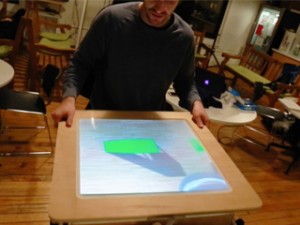Craig Pickard, Joseph Mango
Tilt is a tactile digital gaming and puzzle interface.
http://www.craigwentdigital.com/2014/11/physcomp-final-project-proposal/
Description
Tilt is a tangible user interface (TUI) that combines the benefits of a digital gaming platform with the tactile experience of manipulating a physical object. By choosing Unity3D as the development environment, we're able to utilise the powerful built-in physics engine to deliver realistic and engaging gameplay. Combining a physical interface with a digital application has allowed us to create an extensible multi-layered gaming experience that is, for the time being at least, only limited by our experience with the Unity3D development environment.
The digital application is rear-projected onto the display surface from below. This conceals the hardware and allows the user to engage with the content, instead of focusing on the technology. Tilt's dual-gimbal mechanism provides two-degrees of freedom, allowing the user to tilt the surface around two axes simultaneously. A triple-axis accelerometer determines the surface's orientation and translates that into input variables for the Unity3D environment.
The application that was developed for this prototype has requires the user to navigate a rolling ball through a three-dimensional maze-like environment by tilting the surface of the interface; causing the ball to roll in much the same way a real ball would roll along an inclined plane.
Although the prototype does not boast the feature, for future iterations we aim to incorporate pattern recognition software that will allow the user to place physical objects onto the projection surface, thereby augmenting the gaming experience and allowing the digital and real-world entities to interact with one another.
Haptic and auditory feedback further enhance the gaming experience, creating an engaging and sustained interaction for the user. The gaming experience is designed to be intuitive in its use, and users are encouraged to learn the nuances of manipulating the interface through tutorial-like levels.
Classes
Introduction to Physical Computing

